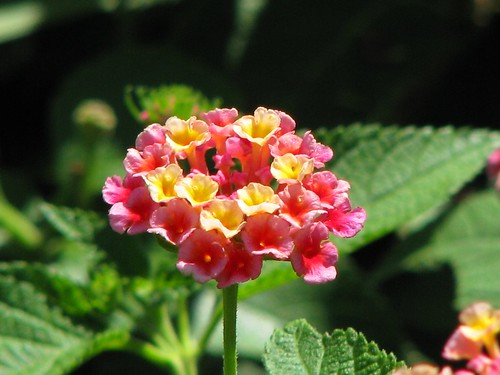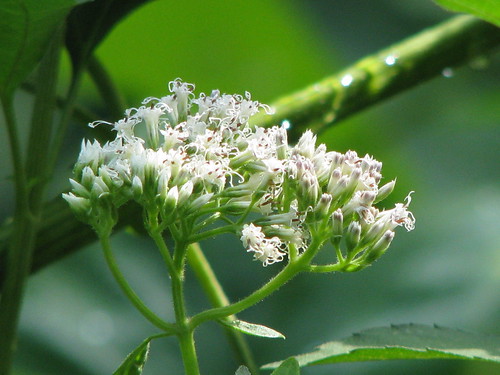Picture a Day February 23, 2011 - Plains Fleabane at Eisenhower Park
Image by mlhradio
Small patches of white flowers dotting the early spring landscape at Eisenhower Park in northwest San Antonio. The Plains Fleabane (Erigeron modestus) is a simple, non-showy wildflower found in Texas and neighboring states.
Picture A Day March 16, 2010 - Lantana (Lantana camara) at Sisterdale
Image by mlhradio
Brightly-blooming Lantana (Lantana camara) during the sweltering summer heat of Texas in the laid-back Hill Country town of Sisterdale. A member of the verbena family, lantana blossoms in bunches of pinks, yellows, purples, reds and oranges. It is a very common wildflower throughout Texas and most of the South, although it is not native to the continental United States.
Find more photos from my 2010 Picture a Day set at: www.flickr.com/photos/matthigh/sets/72157620610035860/
You can also view my 2009 Picture A Day set that started it all at: www.flickr.com/photos/matthigh/sets/72157625855768121/
Picture a Day April 17, 2011 - Pink Evening Primrose (Oenothera speciosa) at Mud Creek
Image by mlhradio
In the waning sunlight at Mud Creek Park in northeast San Antonio, a solitary Pink Evening Primrose (Oenothera speciosa) along the trail. Originally native to the south central grasslands, this wildflower is now found across most of the United States.
Western Horsenettle, Solanum dimidiatum ....
Image by Vietnam Plants & America plants
Dorsal view of leaf with prickles and buds of flower.
Taken on April 29, 2012 in Waco city, Texas state, Southern of America
Vietnamese named : Cà dại lá gai
Common names : Western Horsenettle, TORREY'S NIGHTSHADE.
Scientist name : Solanum dimidiatum Raf.
Synonyms :
Family : Solanaceae / Potato family . Họ Cà
KingdomPlantae – Plants
SubkingdomTracheobionta – Vascular plants
SuperdivisionSpermatophyta – Seed plants
DivisionMagnoliophyta – Flowering plants
ClassMagnoliopsida – Dicotyledons
SubclassAsteridae
OrderSolanales
GenusSolanum L. – nightshade
SpeciesSolanum dimidiatum Raf. – western horsenettle
**** plants.usda.gov/java/profile?symbol=SODI
**** ucjeps.berkeley.edu/cgi-bin/get_JM_treatment.pl?7625,7682...
Perennial 3–8 dm, from rhizome, little-branched; prickles slender, yellowish; hairs stellate, some short-stalked
Leaf 8–15 cm, ovate, wavy to 5–7-lobed, teeth or lobes generally entire
Inflorescence: branches 2–3
Flower: calyx 8–13 mm; corolla 30–50 mm wide, generally purple (white); anthers 8–12 mm, ± equal
Fruit 25–30 mm diam, yellow
**** www.flora.sa.gov.au/efsa/lucid/Solanaceae/Solanum%20speci...
Synonymy
*Solanum dimidiatum Raf., Aut. Bot. 8: 107 (1840)
T: Texas, New Mexico, Arkansas; n.v.
[S. carolinense auct. non L.: H.E. Kleinschmidt & R.W. Johnson, Weeds Queensland 202 (1979)]
Description
Clonal perennial herb to 50 cm, green, pubescent with minute stellate hairs; prickles to 7 mm long, scattered on midrib of lower leaf-surface, petioles and stems.
Leaves ovate to broadly lanceolate; lamina 5–12 cm long, 3–7 cm wide, slightly discolorous, lobed; lobes broadly triangular to oblong; petiole 1–4 cm long.
Inflorescence often forked, few–15–flowered; peduncle 1–2 cm long to first fork; rachis 2–5 cm long; pedicels 1 cm long. Calyx 8–10 mm long; lobes broadly triangular with slender apex, 3–5 mm long. Corolla stellate, shallowly incised, 30–40 mm diam., violet. Anthers 5–7 mm long.
Berry globular, 15–20 mm diam., yellow. Seeds 2.5–4 mm long, pale buff. n=36.
Distribution and ecology
Native to south-eastern U.S.A. Introduced to Australia and naturalised in the Bundaberg area, Qld, where associated with the sugar cane industry.
Bean (2004) records that the species was targetted for eradication and has not been seen since 1972.
Common name
Western horsenettle, Torrey's nightshade
Relationships
While considered to be part of the subg. Leptostemonum its relationships within the group are not known further. It was not part of the Levin et al. (2006) molecular analysis of the subgenus.
**** en.wikipedia.org/wiki/Solanum_dimidiatum
Solanum dimidiatum is a species of nightshade known by the common names Torrey's nightshade, western horsenettle, and robust horsenettle. It is native to the central United States, where it grows in many types of habitat, including disturbed areas. In California it is known as an introduced species and a noxious weed.[1] It is a rhizomatous perennial herb producing an erect stem up to 80 centimeters tall. It is covered in yellow prickles and branched hairs. The leaves may be up to 15 centimeters long, their edges wavy to lobed and sometimes toothed. The inflorescence is a branching array of several flowers. Each flower has a bell-shaped corolla measuring 3 to 5 centimeters wide. It is lavender to purple, or white. The five large, yellow anthers are about a centimeter long. The fruit is a spherical yellow berry up to 3 centimeters wide.
**** www.kswildflower.org/flower_details.php?flowerID=376
www.kswildflower.org/largePhotos.php?imageID=2128&aCa... : LEAF PRICKLES
www.kswildflower.org/largePhotos.php?imageID=2130&aCa... : FLOWERS PICTURE
Picture a Day April 6, 2011 - White Snakeroot (Ageratina altissima) at Landa Park
Image by mlhradio
A common summer wildflower that is found throughout the eastern half of the United States, the White Snakeroot (Ageratina altissima) is also quite poisonous. Fun Fact: Abraham Lincoln's mother died after drinking milk from a cow that grazed on snakeroot! This flower found on the banks of the river at Landa Park in New Braunfels, Texas.
Tidak ada komentar:
Posting Komentar